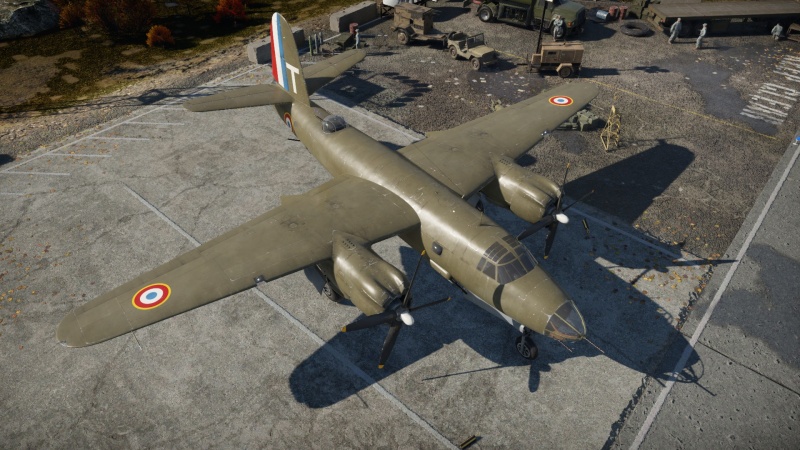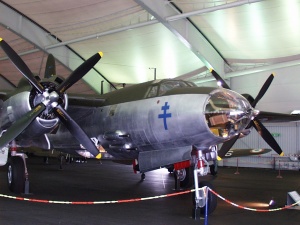B-26C
| This page is about the French bomber B-26C. For the American version, see B-26B. |
Contents
Description
The B-26 Marauder was a medium bomber, designed to be used both for high altitude bombing but to also provide close air support to Allied troops if necessary. France acquired a number of B-26C Marauders after Operation Torch in 1942, replacing the LeO 451s and Douglas DB-7s. They were used in the Allied invasions of Italy and southern France. After the war, most of them were retired, but some stayed for training and testing; one was even converted to test the early SNECMA ATAR jet engines.
It was introduced in Update "Wind of Change". This version of the B-26 Marauder under French service, designated as the B-26C, is virtually the same as the B-26B found in the American tech tree, save for the livery. The different designations were intended to distinguish the batch of extended wing B-26 variants that were produced in Omaha, Nebraska instead of Baltimore, Maryland. Compared to the previous French bombers, the Marauder serves as a "middle ground" between a massive, high-flying bomber like the N.C.223.3 and various fast but lightly armed bombers like LeO 451. The plane is quite sluggish for a medium bomber, but featuring protection and payload closer to that of a heavy bomber. This allows the Marauder to either be used for bombing bases, attacking columns of vehicles, or providing close air support in ground and naval battles with great efficiency.
General info
Flight performance
As expected from a medium-to-large bomber, the B-26C Marauder's flight characteristics are quite similar to its predecessor, the B-25 Mitchell, being generally sluggish to handle but with decent flatline speed. Though due to its bigger size and weight, the general weakness found the B-25's flight performance is further exacerbated. The Marauder will lose quite a lot of energy when making any manoeuvres, especially in vertical manoeuvres that will almost always result in a stall if the plane did not have enough energy prior to the movement. This poor energy retention also results in the plane having very poor climb rate, even when compared to heavy bombers. The plane's control surface lock up when exceeding 540 km/h, and the wings will break if exceeding 580 km/h.
On the bright side, the Marauder's engines provide enough power to accelerate in shallow dives and allows the plane to reach the target faster. This also helps in emergency cases as the Marauder is also capable of flying with one engine in case the other is knocked out.
| Characteristics | Max Speed (km/h at 3,962 m) |
Max altitude (metres) |
Turn time (seconds) |
Rate of climb (metres/second) |
Take-off run (metres) | |||
|---|---|---|---|---|---|---|---|---|
| AB | RB | AB | RB | AB | RB | |||
| Stock | 403 | 387 | 35.3 | 36.6 | 2.4 | 2.4 | 950 | |
| Upgraded | 525 | 491 | 32.8 | 34.0 | 10.3 | 5.6 | ||
Details
| Features | ||||
|---|---|---|---|---|
| Combat flaps | Take-off flaps | Landing flaps | Air brakes | Arrestor gear |
| ✓ | ✓ | ✓ | X | X |
| Limits | ||||||
|---|---|---|---|---|---|---|
| Wings (km/h) | Gear (km/h) | Flaps (km/h) | Max Static G | |||
| Combat | Take-off | Landing | + | - | ||
| 568 | 382 | 320 | 297 | ~__ | ~__ | |
| Optimal velocities (km/h) | |||
|---|---|---|---|
| Ailerons | Rudder | Elevators | Radiator |
| < 270 | < 320 | < 370 | > ___ |
Survivability and armour
As with other American medium bombers, the B-26C is fairly survivable. The plane features multiple layers of armour protecting the pilot and gunners; combined with a sturdy airframe, this allows the plane to tank quite a lot of hits, especially from machine guns.
The two Pratt & Whitney R-2800 "Twin Wasp" engines provide an additional failsafe to the plane, as it allows the pilot to fly with one engine knocked out and limp back to the base for repair.
However, being larger than the B-25 and with less effective frontal armament, the B-26C is quite prone to pilot snipes from frontal engagements. As such, avoid diving head-first into the enemy at all costs.
Modifications and economy
Since the stock payload is as potent as the 600 lb bomb payload, B-26C pilots have more freedom when it comes to choosing an upgrade. Though an additional payload unlock is recommended, as the 600 lb payload is a rank 2 modification which allows you to unlock rank 3 modification faster, and the payload is generally easier to use.
Armaments
Offensive armament
The B-26C is armed with:
- 1 x 12.7 mm M2 Browning machine gun, nose-mounted (200 rpg)
- 4 x 12.7 mm M2 Browning machine guns, cheek-mounted (250 rpg upper + 200 rpg lower = 900 total)
The B-26C features five .50 cal Browning machine guns mounted on the nose and cheeks as its offensive armament. These guns were mounted with the intent of being used to strafe ground targets, which the Marauder is perfectly capable of doing. However, unlike the B-25, due to the guns being mounted quite low on the fuselage and being placed quite far apart, this results in the guns having poor convergence and thus are very hard to aim at an enemy plane. This is not helped by the fact that the plane has much worse handling than the B-25 and that its large tail directly blocks the aiming point. Because of this, it is better used against ground targets or slow-flying AI planes instead.
Suspended armament
The B-26C can be outfitted with the following ordnance:
- 30 x 100 lb AN-M30A1 bombs (3,000 lb total)
- 14 x 300 lb H.E. M31 bombs (4,200 lb total)
- 8 x 600 lb H.E. M32 bombs (4,800 lb total)
- 4 x 1,000 lb AN-M65A1 bombs (4,000 lb total)
- 2 x 2,000 lb AN-M66A2 bombs (4,000 lb total)
- 2 x 1,600 lb AN-Mk 1 bombs (3,200 lb total)
- 1 x 2,216 lb Mk.13-1 torpedo
The B-26C features a large payload for its type. The stock payload of 30 x 100 lb bombs are actually quite potent, being able to take out two bases in downtier and one in uptier, though due to the bomb series set up, the payload often requires micromanagement to precisely manage the drop. Due to the quantity, the 100 lb payload are very useful against columns of vehicles. The most "optimal" payload against bases in air battles is the 8 x 600 lb bombs, which can destroy the same number of bases as the 100 lb bombs, but are much easier to handle.
Other than the smaller bombs, the Marauder also has access to large bombs to tackle ground and naval targets. The plane has access to 4 x 1,000 lb or 2 x 2,000 lb bombs to provide destructive CAS against the enemy team.
The Marauder also has an option to mount a single Mk.13 torpedo. However, only the notoriously terrible, early version of the Mk. 13 is available, with very poor drop speed and range. This, combined with the plane's large size, means that the Marauder pilot should rely on its large bombs against enemy ships instead.
Defensive armament
The B-26C is defended by:
- 1 x 12.7 mm M2 Browning machine gun, nose turret (270 rpg)
- 2 x 12.7 mm M2 Browning machine guns, dorsal turret (400 rpg = 800 total)
- 1 x 12.7 mm M2 Browning machine gun, 2 x beam turrets (240 rpg)
- 2 x 12.7 mm M2 Browning machine guns, tail turret (800 rpg = 1,600 total)
For defensive purposes, the B-26C features seven .50 cal Browning machine guns, with noticeable focus on the tail: all but one of these guns can be directed behind the plane, as the Marauder were designed to outrun the opponent rather than confront them. As such, the Marauder features strong defensive firepower at the rear but mostly lacks any self-defense measures anywhere else. This can be exploited by enemy pilots by engaging either at the poorly-protected front or the blind spot at the side and belly of the aircraft. Because of this, B-26C pilots should attempt to face their tail at any chaser if possible to have more chance of surviving.
Usage in battles
Being essentially an upsized B-25, the B-26C Marauder excels at fast bombing using its speed to quickly reach a target. However, due to the Marauder being significantly larger, the plane has several limitations that prevents it from being played aggressively like its predecessor. As such, the playstyle of the B-26 is somewhat similar to other medium bombers: quickly approaching the target, drop the bomb, and then retreat.
Due to the frontally-mounted MGs, the Marauder can be used to strafe soft targets when the payload is used up. Though due to the plane's generally poor flight performance, be wary of an enemy from above as the plane has little chance of getting away from them, especially if they are coming from the front.
Manual Engine Control
| MEC elements | ||||||
|---|---|---|---|---|---|---|
| Mixer | Pitch | Radiator | Supercharger | Turbocharger | ||
| Oil | Water | Type | ||||
| Controllable | Controllable Not auto controlled |
Not controllable Not auto controlled |
Controllable Auto control available |
Separate | Controllable 2 gears |
Not controllable |
Pros and cons
Pros:
- Good payload consists of bombs of various size for different targets
- Tough airframe with armour plates protecting pilots and gunners, capable of soaking up damage
- Tricycle landing gear allows the plane to land and take off on smaller airfields
- Powerful engines provide decent flat acceleration and also allow the plane to fly with one engine
- Adequate defensive armament at the rear
- Access to five machine guns for strafing ground targets
Cons:
- Quite large in size, can be easily targeted
- Wide frontal gun convergence resulting into inaccuracy, especially against aircraft
- Low structural limit speed (~580 km/h), can make dive bombing quite tricky to perform
- Very poor climb rate and energy retention
- Poor overall manoeuvrability, especially at higher speed
- Limited defensive gun coverage at the front, side, and below
History
After the conclusion of Operation Torch (the Allied invasion of North Africa) in November 1942, the United States supplied the Free French Air Forces with a batch of B-26C Marauders to replace the now obsolete Lioré et Olivier LeO 451s and Douglas DB-7s. These B-26s were prominently used during the invasion of Italy and southern France. At the end of the war, seven out of nine of the Free French's bomber squadrons used the Marauder, taking part in 270 missions and 4,884 sorties. The Marauder were decommissioned from French service in July 1945, though some of them were retained as trainers and test beds, including one that was converted to test SNECMA ATAR jet engines.
Media
- Skins
See also
External links
| Glenn L. Martin Company | |
|---|---|
| Attackers | AM-1 |
| Bombers | B-10B · B-26B · PBM-1 · PBM-3 · PBM-5A |
| Jet bombers | B-57A* · B-57B* |
| Export | Martin 139WC · Martin 167-A3 · B-26C |
| * These aircraft were license-built from The English Electric Company Limited who developed and built the British English Electric Canberra. | |
| France bombers | |
|---|---|
| Farman | F.222.2 · N.C.223.3 |
| Latécoère | Late 298D |
| Potez | Potez 633 |
| Liore et Olivier | LeO 451 early · LeO 451 late |
| Bloch | M.B.174A-3 · M.B.162 · M.B.175T |
| American | V-156-F · Martin 167-A3 · ▄A-35B · ▄SB2C-5 · B-26C · ▄PBY-5A Late · ▄PB4Y-2 |
| British | Lancaster MR.7 |






